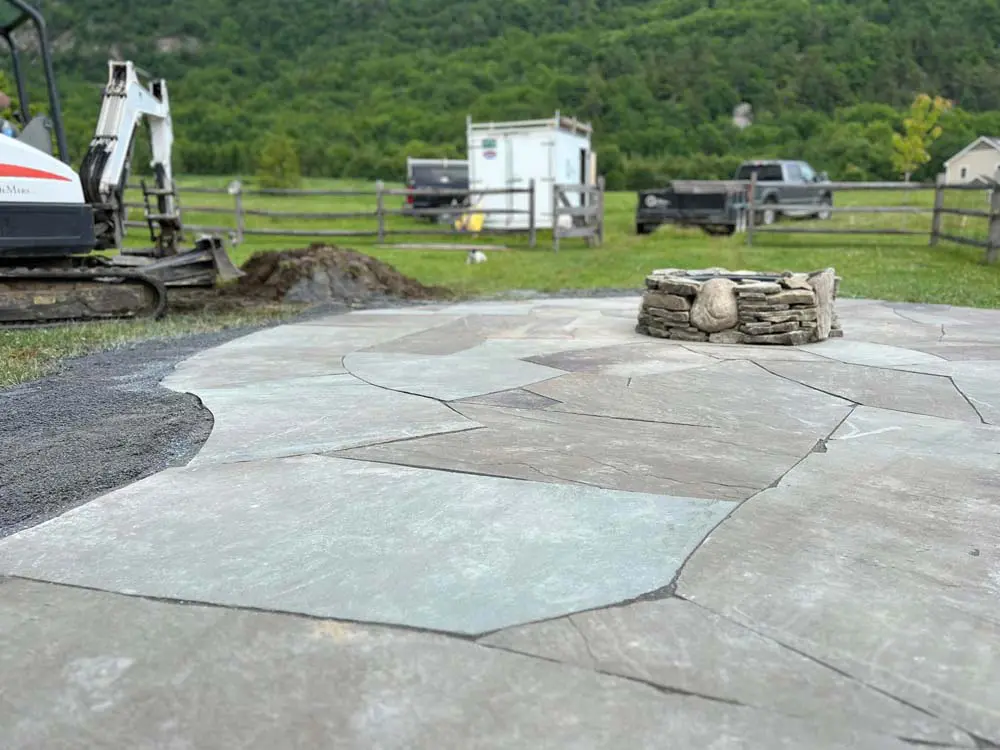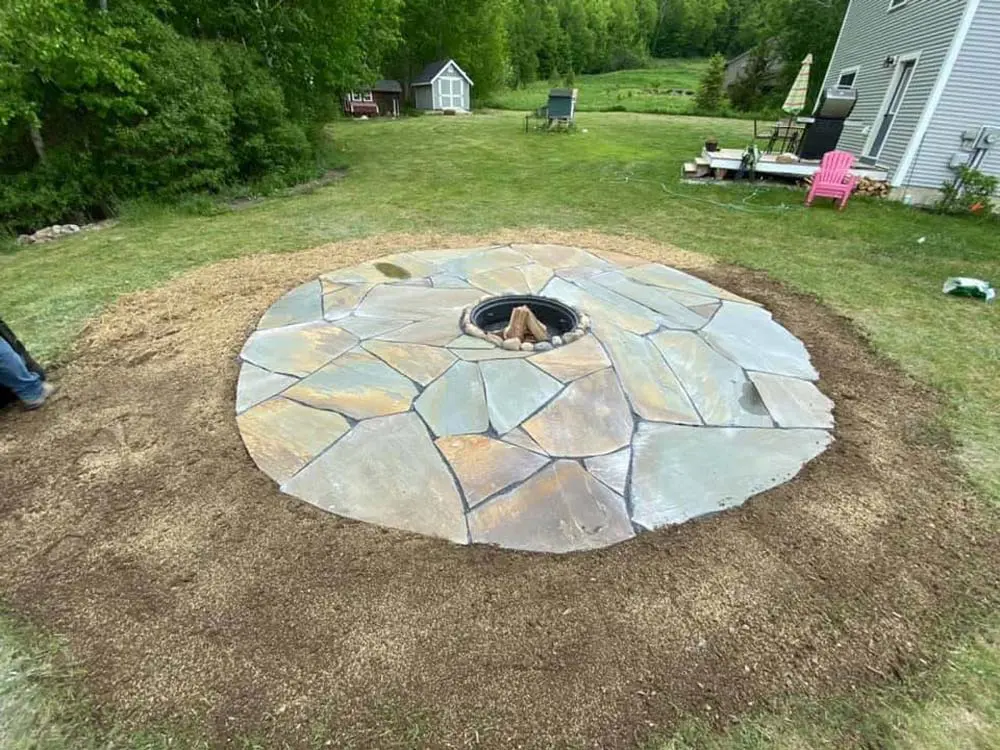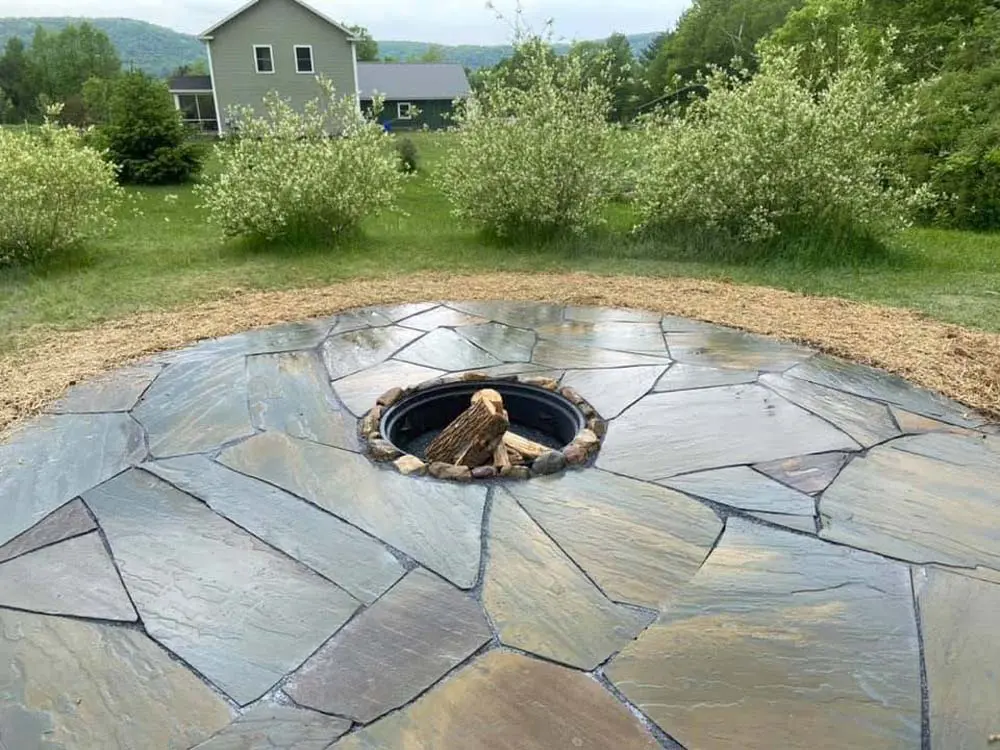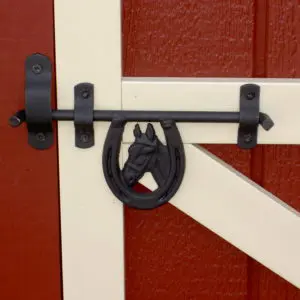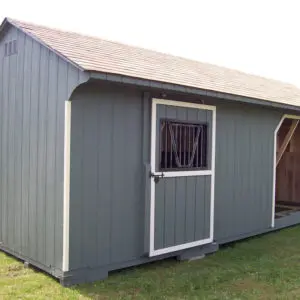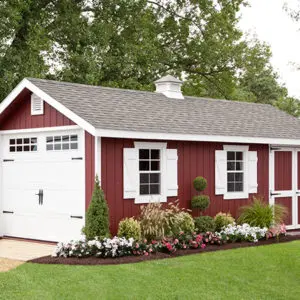
What's New at
Livingston Farm
The Livingston Farm Official Blog- Posted by Livingston Farm

Natural Stone Fire Pits: Everything You Need to Know

Credit EH Landworks Natural Stone Fire Pits: Everything You Need to Know
There’s nothing quite like gathering around a warm, crackling fire with family and friends. A natural stone fire pit not only creates a cozy ambiance but also adds timeless beauty to your outdoor space. At Livingston Farm, we believe in helping homeowners design functional, durable, and stunning outdoor spaces. If you’re considering a natural stone fire pit for your property, here’s everything you need to know.
Why Choose a Natural Stone Fire Pit?
Natural stone is the perfect choice for fire pits, thanks to its durability, aesthetics, and versatility. Here’s why homeowners love using natural stone for their outdoor fire features:
1. Durability
Natural stone can withstand high temperatures, harsh weather conditions, and everyday wear and tear. A well-built stone fire pit will last for years with minimal maintenance.
2. Timeless Beauty
Each piece of natural stone is unique, with its own colors, textures, and patterns. This ensures your fire pit will be a one-of-a-kind focal point in your backyard.
3. Versatility
Whether you prefer a rustic, traditional design or a sleek, modern look, natural stone fire pits can be customized to fit your style. Choose from options like bluestone, granite, or fieldstone to match your outdoor decor.
Types of Natural Stone Fire Pits
When planning your fire pit, you’ll need to choose between two main types:
1. Wood-Burning Fire Pits
For a classic campfire experience, a wood-burning fire pit is the way to go. The natural stone retains and radiates heat, keeping you warm long after the fire dies down.
2. Gas-Fueled Fire Pits
If convenience is a priority, a gas-fueled fire pit offers quick ignition and easy control. Natural stone surrounds provide a sturdy, heat-resistant structure while enhancing the fire pit’s aesthetic appeal.
How to Build a Natural Stone Fire Pit
Building a natural stone fire pit requires proper planning and execution to ensure safety and durability. Here’s a quick overview:
Step 1: Choose Your Location
Pick a safe spot that’s at least 10-20 feet away from structures, trees, and overhanging branches. Make sure the ground is level and clear of flammable materials.
Step 2: Select Your Materials
At Livingston Farm, we offer a wide range of natural stone options for fire pits, including fieldstone, granite, and bluestone. Choose the type that best fits your design and functional needs.
Step 3: Build a Solid Base
Lay a foundation using gravel or sand to ensure stability and proper drainage. This step is crucial for the longevity of your fire pit.
Step 4: Stack the Stone
Using fire-resistant mortar, carefully stack the natural stone to create the walls of your fire pit. Leave gaps for ventilation if you’re building a wood-burning design.
Step 5: Install a Fire Ring
For added safety and protection, place a metal fire ring inside the stone structure. This prevents direct contact between the flames and the stone.
Maintenance Tips for Your Natural Stone Fire Pit
A natural stone fire pit is low-maintenance, but a little care goes a long way in preserving its beauty and functionality:
Clean regularly: Remove ashes and debris after each use.
Protect from the elements: Use a weatherproof cover to protect your fire pit from rain and snow.
Inspect annually:** Check for cracks or damage and repair as needed to maintain safety.
Benefits of Adding a Natural Stone Fire Pit to Your Property
Increased Property Value: A professionally built fire pit adds aesthetic and functional value to your home.
Year-Round Enjoyment: Stay warm on chilly evenings and extend your outdoor entertaining season.
Gathering Spot: Create lasting memories with loved ones around your beautiful natural stone fire pit.
Why Choose Livingston Farm for Your Natural Stone Fire Pit?
At Livingston Farm, we’re proud to offer premium natural stone fire materials, and expert guidance. Our wide selection of high-quality materials ensures you’ll find the perfect match for your project. Plus, our team is here to answer your questions and help you every step of the way.
Get Started on Your Natural Stone Fire Pit Today
Ready to transform your backyard with a natural stone fire pit? Visit us to explore our selection of natural stone. Contact us today to get started on designing your dream outdoor space!






Contact Us
Ready to get started on your next project? Give us a call at 802.382.0992, complete the contact form below or swing by our location. We’re located at 40 South Route 116, Bristol, VT 05443 – just a short drive from Middlebury and Burlington, VT.
December 10, 202423 - Posted by Livingston Farm

How to Prepare Your Shed or Garage for Winter

Preparing Your Shed or Garage for Winter: Essential Tips
Winter can be harsh on your property, especially on your shed or garage. At Livingston Farm, we know how vital it is to protect your belongings and keep your structures in top shape year-round. Preparing your shed or garage for winter not only safeguards your investments but also prevents costly repairs. Here are some expert tips to winterize your shed or garage and keep it safe through the colder months.
1. Inspect and Repair the Structure
Before the first snow falls, inspect your shed or garage for any signs of damage. Look for cracks, loose shingles, and damaged siding. Addressing these issues early can prevent snow and moisture from seeping in, which can lead to mold and structural damage. Reinforce your shed or garage with weather-resistant materials if necessary,
2. Seal Doors and Windows
Gaps around doors and windows allow cold air, snow, and rain to enter, potentially damaging stored items. Check for any leaks and seal them with weatherstripping or caulk. This simple step can make a big difference in keeping your shed or garage warmer and protecting your stored belongings.
3. Organize and Declutter
Organizing your shed or garage makes it easier to find essentials and helps prevent damage to valuable items during winter. Clear out anything you no longer need and make sure that important tools, seasonal decorations, and equipment are stored in waterproof bins or on sturdy shelving.
4. Check Roof and Gutters (If Applicable)
Leaves and debris can clog gutters and lead to water buildup on your shed or garage roof, which is especially dangerous in freezing temperatures. Clear out gutters and inspect the roof for loose or damaged shingles. Installing gutter guards can make future maintenance easier and keep water away from your building’s foundation.
5. Protect Flooring and Stored Items
Raised shelving is also a great option to keep stored items off the ground and safe from water damage.
6. Insulate Pipes and Plumbing (If Applicable)
If your shed or garage has plumbing, make sure to insulate any exposed pipes to prevent freezing. Frozen pipes can burst, causing significant water damage. Wrapping pipes with insulation sleeves or heat tape can go a long way in preventing expensive repairs.
7. Consider Installing a Dehumidifier
Humidity can cause damage to your stored items and lead to mold growth. Adding a dehumidifier to your garage or shed will help keep moisture levels in check. This is especially important for wooden items, tools, clothing and any other valuables sensitive to moisture.
Winterizing Your Shed or Garage: A Worthwhile Investment
Proper winter preparation will keep your shed or garage safe and functional through the season. From sealing windows to organizing your storage, these small steps can prevent big headaches down the line. At Livingston Farm, we offer a wide range of products and services to help you winter-proof your space and ensure it’s ready for any winter challenge.
Contact Us
Ready to get started on your next project? Give us a call at 802.382.0992, complete the contact form below or swing by our location. We’re located at 40 South Route 116, Bristol, VT 05443 – just a short drive from Middlebury and Burlington, VT.
- Posted by Livingston Farm

Ultimate Guide to Poly Lumber

The Ultimate Guide to Poly Lumber: Benefits and Comparisons with Wood, Plastic, and Metal Furniture
Today, we’re diving into the world of poly lumber, a versatile and sustainable material that is revolutionizing outdoor furniture and home improvement. We’ll explore what poly lumber is, its top benefits, and why it’s a superior choice compared to traditional materials like wood, plastic, and metal.
What is Poly Lumber?
Poly lumber, also known as polywood, is a synthetic material made from recycled plastics, primarily high-density polyethylene (HDPE). This innovative material mimics the look and feel of natural wood but offers enhanced durability and resistance to the elements. Poly lumber is commonly used for outdoor furniture, decking, and other applications where traditional wood would typically degrade over time.
Top 3 Benefits of Poly Lumber
- Eco-Friendly and Sustainable
- Poly lumber is made from recycled plastics, reducing the amount of waste in landfills and minimizing the need for virgin plastic production. By choosing poly lumber products, you are making an environmentally responsible decision that contributes to a sustainable future.
- Poly lumber is made from recycled plastics, reducing the amount of waste in landfills and minimizing the need for virgin plastic production. By choosing poly lumber products, you are making an environmentally responsible decision that contributes to a sustainable future.
- Durability and Low Maintenance
- Unlike wood, poly lumber does not splinter, crack, or warp. It is resistant to moisture, insects, and UV rays, making it an ideal choice for outdoor furniture that will withstand various weather conditions. Poly lumber requires minimal maintenance – no need for painting, staining, or sealing. A simple wash with soap and water keeps it looking new for years.
- Unlike wood, poly lumber does not splinter, crack, or warp. It is resistant to moisture, insects, and UV rays, making it an ideal choice for outdoor furniture that will withstand various weather conditions. Poly lumber requires minimal maintenance – no need for painting, staining, or sealing. A simple wash with soap and water keeps it looking new for years.
- Aesthetic Versatility
- Poly lumber is available in a wide range of colors and styles, allowing you to customize your outdoor space to match your aesthetic preferences. Whether you prefer the look of natural wood grains or vibrant, bold colors, poly lumber can be tailored to suit your design vision.
Advantages of Poly Lumber Built Furniture
- Weather Resistance: Poly lumber furniture is impervious to rain, snow, and sun exposure, ensuring it remains intact and visually appealing regardless of the season.
- Longevity: Due to its robust construction, poly lumber furniture often outlasts traditional wooden furniture, providing a long-term investment for your outdoor living space.
- Eco-Conscious Choice: As poly lumber is crafted from recycled materials, it promotes environmental sustainability, making it an excellent choice for eco-conscious consumers.
- Comfort and Safety: With its smooth finish and splinter-free surface, poly lumber furniture provides a comfortable and safe seating option for families and guests.
Comparing Poly Lumber to Wood, Plastic, and Metal Furniture
- Wood
- Pros: Classic and timeless appeal, natural look and feel, can be easily customized.
- Cons: Prone to rot, insects, and weather damage; requires regular maintenance (painting, staining, sealing); can splinter and crack over time.
- Plastic
- Pros: Lightweight, inexpensive, and available in various colors and styles.
- Cons: Less durable, can become brittle and crack over time, often lacks the aesthetic appeal of wood or poly lumber, can contribute to environmental pollution if not recycled properly.
- Metal
- Pros: Strong and durable, can withstand heavy use and weight, often has a modern and sleek appearance.
- Cons: Prone to rust and corrosion if not treated properly, can become hot to the touch in direct sunlight, heavier and harder to move than wood or plastic.
- Poly Lumber
- Pros: Extremely durable, low maintenance, eco-friendly, resistant to weather, insects, and UV rays, available in a wide range of colors and styles, splinter-free and safe.
- Cons: Generally higher initial cost compared to plastic and some wood options, but offers better long-term value due to its longevity and low maintenance requirements.
Conclusion
Poly lumber is a game-changer in the world of outdoor furniture, offering an unbeatable combination of durability, low maintenance, and environmental sustainability. By choosing poly lumber furniture, you are investing in products that will not only enhance your outdoor living space but also contribute to a healthier planet. At Livingston Farm, we are proud to offer a wide selection of high-quality poly lumber furniture to meet your needs and exceed your expectations.
Explore our collection today and experience the many benefits of poly lumber for yourself!
Contact Us
Ready to get started on your next project? Give us a call at 802.382.0992, complete the contact form below or swing by our location. We’re located at 40 South Route 116, Bristol, VT 05443 – just a short drive from Middlebury and Burlington, VT.
- Eco-Friendly and Sustainable
- Posted by Livingston Farm

Enhance Your Landscaping with Aggregates

Enhance Your Landscaping with Aggregates from Livingston Farm
Livingston Farm offers a wide variety of aggregates available for delivery, perfect for any landscaping project.
What Are Aggregates?
Aggregates are a blend of materials such as crushed stone, recycled asphalt, gravel, slate, limestone, granite, and other mined minerals. These materials are used in various architectural applications, including creating beautiful and functional landscapes. Landscaping aggregates are specially formulated to enhance the aesthetics and utility of your outdoor spaces.
Main Types of Aggregates for Landscaping
Gravel and Crushed Stone
Combining gravel with crushed stone like limestone creates an ideal mix for landscaping. This method has been used for years, allowing you to tweak the size and composition to fit your design goals perfectly.
Sand
Sand aggregates, consisting of fine sandstones, are excellent for children’s playgrounds, recreational facilities, and sports surfaces due to their soft texture and good drainage properties.
Top Soil
Top soil aggregates, a mix of sand and compost, are typically used for general lawn repair or mixed with soil for plants needing extra hydration.
Benefits of Using Aggregates in Your Landscaping Project
Easy to Create Walkways and Borders
Aggregates can be used to create durable and aesthetically pleasing walkways, driveways, and borders. Colored aggregates can match or complement your home’s style, and combining them with other larger decorative stones can achieve a modern yet classic look.
Simple Maintenance
Once laid out, landscaping aggregates require minimal maintenance. You only need to manage weed growth and occasionally top up the aggregates, making them a long-lasting solution.
Natural Drainage
Aggregates like top soil can manage water flow and drainage, especially on sloped properties. Top soil retains water where needed, while sand promotes free water flow.
Affordable Pricing
Aggregates are among the most cost-effective landscaping materials. Their durability and low maintenance make them a smart long-term investment.
Wide Range of Sizes and Colors
From fine sand to larger stones, aggregates come in various sizes and colors, allowing for creative and unique landscaping designs. Using multiple sizes can create an uncommon yet beautiful style for your landscape.
How to Choose the Right Aggregates
Choosing the right aggregate involves understanding the needs of your landscape. Consider these points:
Purpose
For drainage, use permeable aggregates like crushed rock. For walkways, choose stable options like decomposed granite. For decoration, explore colorful gravel or glass.
Size
Larger stones for drainage, smaller ones for walkways. Angular stones for stability, rounded ones for smoothness.
Look & Feel
Consider color, texture, and how they complement your surroundings.
Practicalities
Think about maintenance, safety, and local availability.
Landscaping Ideas with Aggregates
Cover Slopes and Paths
Use aggregates to create beautiful pathways or cover slopes. Choose colors that complement your home’s exterior for a cohesive look.
Alternative to Mulch
Aggregates can replace mulch in flower beds and gardens, offering a low-maintenance and long-lasting option.
Replace Grass
If maintaining grass is too labor-intensive, aggregates provide an attractive and practical alternative.
As Grout for Unique Contrast
Use aggregates as grout between paving stones to create a distinctive look.
Rock Borders
Surround larger rocks with smaller aggregates for added visual interest.
Find Your Favorite Aggregate Today!
Livingston Farm offers a wide range of landscaping aggregates to meet your project needs. Our high-quality products ensure you find the perfect fit for your landscape. Explore our selection and start transforming your outdoor space today!
Contact Us
Ready to get started on your next project? Give us a call at 802.382.0992, complete the contact form below or swing by our location. We’re located at 40 South Route 116, Bristol, VT 05443 – just a short drive from Middlebury and Burlington, VT.
- Posted by Livingston Farm

Harvesting from Your Garden: Best Practices for a Bountiful Yield

Harvesting from Your Garden: Best Practices for a Bountiful Yield
Harvesting from your garden is the moment we’ve all been waiting for! To ensure a bountiful and healthy yield, it’s essential to understand the best practices for harvesting your crops. Let’s delve into why timing and conditions matter so much.
Timing Matters: Why Not Harvest When Wet?
You may have heard it’s best to harvest in the morning, but also not to harvest when the plants are wet. This might seem contradictory on dewy mornings, but there’s a good reason behind the ‘not wet and not wilted’ advice.
When you harvest from a wet plant, you open a wound that can become an entry point for diseases. Fungal and bacterial diseases like blight, powdery mildew, and rust thrive in moist conditions. Harvesting wet plants increases the risk of these diseases spreading, as the moisture can carry pathogens from one plant to another.
Additionally, wet leaves have more open pores, making it easier for diseases to enter and harder for the plant to defend itself. To minimize the risk, avoid touching or harvesting plants when they are wet. This is especially important after it rains, as rainwater can spread germs between plants.
The Right Time to Water
Plants absorb most water through their roots and leaves in the morning. Later in the day, to retain moisture, the pores on the leaves close. This can make the plant look like it needs water in the afternoon, but it’s just conserving moisture. Watering in the middle of the day is often ineffective, as the plant cannot absorb much water and the heat causes evaporation. Mulching your garden helps retain soil moisture, preventing it from turning into gas and evaporating.
Note: For seeds and tiny seedlings, you might still need to water them during the day to keep the soil moist. Mulching shallow-rooted plants can also be beneficial.
Harvesting Tips for Optimal Flavor and Freshness
Avoid Harvesting When Dry
Herbs are best harvested when they are not wet but not yet wilted. Harvesting them during this stage ensures they retain their best flavor, as water on the leaves or heat from the sun can cause essential oils to vaporize. If you can smell the herbs before you reach the plants, it’s too late to harvest, as the oils have already dissipated.
Specific Tips for Different Crops
Berries: Only pick berries when they are dry. Their thin skin and high respiration rate make them prone to mold if harvested when wet.
Tomatoes: Avoid picking tomatoes after rain as they are more susceptible to diseases and tend to split. Pick almost ripe tomatoes before a big storm to let them ripen indoors.
Beans: Avoid harvesting beans when wet to prevent the spread of bacterial bean blight.
Cucumbers and Zucchini: Harvest often and while they are small for better texture and flavor. Use clean, sharp tools to avoid damaging the plants.
General Harvesting Practices
Clean Your Tools: Always clean snips or knives between harvests to prevent spreading diseases. Use rubbing alcohol or hand sanitizer to disinfect the blades.
Dunk in Water: Submerging cucumbers, celery, and lettuce in clean water for an hour post-harvest can help maintain moisture content.
Use Smooth Containers: To avoid bruising or puncturing freshly harvested veggies, use clean, smooth containers.
By following these best practices, you can ensure your garden remains healthy and productive, providing you with delicious and nutritious food throughout the season. Happy harvesting!
Contact Us
Ready to get started on your next project? Give us a call at 802.382.0992, complete the contact form below or swing by our location. We’re located at 40 South Route 116, Bristol, VT 05443 – just a short drive from Middlebury and Burlington, VT.
- Posted by Livingston Farm

Why I Love the 4th of July: Celebrating Family, Fun, and Tradition

Why I Love the 4th of July: Celebrating Family, Fun, and Tradition
As the owner of Livingston Farm, the 4th of July has always been a cherished time for me. This holiday that marks our independence from Great Britain holds a unique place in my heart for several reasons, all of which revolve around family, tradition, and the simple joys of summer. Let me share with you why the 4th of July is such a beloved holiday for me.
Family Gatherings and New Traditions
The 4th of July is all about family for me. With two grandchildren under the age of 3 years old, our celebrations have taken on a new level of excitement. Watching their eyes light up at the sight of fireworks and seeing them enjoy their first tastes of classic BBQ food makes the day even more special. Our family gatherings are filled with laughter, games, and quality time together. It’s a day when we can all relax, catch up, and enjoy each other’s company without the rush and stress of our usual routines.
Barbecues and Waterskiing Adventures
One of my favorite parts of the 4th of July is firing up the grill and cooking up some delicious hamburgers – my absolute favorite food. There’s something truly special about sharing a meal with loved ones under the open sky, surrounded by the beauty of nature.
Another highlight is waterskiing with my kids. Waterskiing has been a family tradition ever since my children were little. All of my children learned how to waterski before they were 6 years old, and it’s a joy to see them now passing on that love of the sport to the next generation. The thrill of gliding across the water, the splash of the waves, and the cheers from the family on the shore make for unforgettable moments.
Beautiful Weather and Good Vibes
The 4th of July typically brings with it some of the best weather of the year. Warm, sunny days and clear, starry nights create the perfect backdrop for outdoor celebrations. Whether we’re playing lawn games, taking a dip in the lake, or simply lounging in the shade, the pleasant weather adds to the overall sense of well-being and joy. It’s a time when people are generally in high spirits, and the positive energy is contagious.
A Stress-Free Holiday
Unlike many other holidays, the 4th of July is refreshingly low-pressure. There’s no need to worry about buying gifts, decorating the house, or preparing elaborate meals. Instead, it’s all about simple pleasures – grilling burgers and hot dogs, enjoying cold drinks, and maybe indulging in some sweet treats. This laid-back approach makes it a truly relaxing holiday, where the focus is on having fun and making memories.
Long-Standing Traditions: The Bristol Parade and Outhouse Races
One of my most cherished 4th of July traditions is attending the Bristol parade and watching the annual outhouse races. I’ve been going to these events for many, many years, and they have become an integral part of my celebration. There’s something magical about watching the floats, marching bands, and community groups as they make their way down the main street, all while surrounded by fellow parade-goers who are equally enthusiastic about the day. The outhouse races add a unique and entertaining twist, showcasing the creativity and humor of our community.
A Special Goal: Riding in the Parade
This year, I have a special goal – to ride with my granddaughter in the parade as she throws candy to all the parade-goers. Seeing the joy on her face as she participates in this long-standing tradition will be a highlight of the day. It’s moments like these that make the 4th of July truly unforgettable.
A Day Off to Celebrate
Having worked on the Livingston dairy farm until I was 36 years old, I know the meaning of hard work and dedication. However, ever since selling the cows, I’ve made sure to take July 4th off every year. It’s a day to step back from the daily grind and truly appreciate the blessings of family, friends, and freedom.
The 4th of July is a day that brings together all the elements of a perfect celebration – family, friends, good weather, and a carefree atmosphere. It’s a time to embrace tradition, enjoy the simple pleasures of summer, and create lasting memories. As the owner of Livingston Farm, I feel incredibly fortunate to be able to celebrate this wonderful holiday surrounded by the people and the Vermont I love. My hope is for all of our clients and their families to also have a 4th of July celebration filled with joy, laughter, and togetherness!
Happy 4th of July, everyone!
Contact Us
Ready to get started on your next project? Give us a call at 802.382.0992, complete the contact form below or swing by our location. We’re located at 40 South Route 116, Bristol, VT 05443 – just a short drive from Middlebury and Burlington, VT.
- Posted by Livingston Farm

Discover the Top Exterior Shed Color Trends for 2024

Discover the Top Exterior Shed Color Trends for 2024
As we step into 2024, the landscape of exterior design is pulsating with vibrant new color trends, promising to infuse our outdoor spaces with fresh energy and style. If you’re on the hunt for the latest in exterior shed color trends, you’re in the perfect spot. This year’s palette is a rich tapestry of hues, expertly predicted by top designers to align with contemporary tastes and lifestyles. Whether you’re contemplating a complete home makeover, aiming to rejuvenate your shed, or simply looking to introduce a pop of color, the trending palettes of 2024 are bound to captivate and inspire.
The evolution of exterior colors for homes and sheds is a reflection of our dynamic lives. Amid the daily rush, the sight of a beautifully painted exterior can be a comforting welcome. This year, we’re seeing a delightful mix of warm neutrals and bold contrasts, each resonating with personal style, ensuring your home’s exterior mirrors the warmth of its interiors. Let’s dive into the top ten colors that are set to define 2024, helping you select the shade that truly speaks to your aesthetic sensibilities.
What’s Trending in 2024
Embrace the Warmth of Neutrals: This year, neutrals are shedding their cool undertones for warmer, earth-inspired shades. These new neutrals are a nod to nature, promising to seamlessly integrate your outdoor structures with the surrounding environment.
The Brilliance of Bright White: Far from being a bold move, opting for white trim can subtly elevate your exterior, drawing attention to architectural details with its clean, crisp lines.
Doors That Tell a Story: Your front door is more than an entryway; it’s an opportunity to express personality. This year, make it pop with a color that complements yet stands out against the rest of your palette.
Dare to Go Dark: With a shift towards darker, more industrial hues, 2024 brings an edge to exteriors. Paired with lighter accents, these shades promise a dramatic yet harmonious balance.
The Timeless Appeal of Black and White: High contrast never goes out of style, and a black and white theme remains a sophisticated choice, offering stark beauty and elegant simplicity.
The Charm of Two-Tone: Why settle for one when you can beautifully blend two complementary colors? This trend offers a fresh perspective on exterior aesthetics.
The Versatility of Blues: From the softest whispers of blue to the deepest indigo, this color family offers endless possibilities, easily adaptable to various design themes.
Farmhouse Flair with Rustic Reds: Channel the rustic charm of farmhouse aesthetics with deep reds, accented by crisp whites for a look that’s both timeless and trendy.
Go Green: Inspired by nature, earthy greens can transform your exterior into a serene, inviting space that harmonizes with the natural world.
Modern Neutrals: This year is all about bold contrasts and the thoughtful use of natural elements, creating a modern yet inviting outdoor space.
At Livingston Farm in Vermont, we’re more than just a name; we’re a team dedicated to making your creative visions come to life. Renowned for our commitment to customer satisfaction, we’re here to guide you through every step of your exterior update, from sheds to in-law suites and beyond. Reach out to us and embark on a journey to transform your outdoor space into a reflection of the latest trends and your unique style.
Contact Us
Ready to get started on your next project? Give us a call at 802.382.0992, complete the contact form below or swing by our location. We’re located at 40 South Route 116, Bristol, VT 05443 – just a short drive from Middlebury and Burlington, VT.
- Posted by Livingston Farm

Spring Into Action: The Essential Guide to Outdoor Spring Cleanup

Spring Into Action: The Essential Guide to Outdoor Spring Cleanup
As the last vestiges of winter melt away, it’s time to rejuvenate your outdoor space. Spring cleanup is not just a ritual; it’s an investment in the health and beauty of your property. At Livingston Farm, we understand the transformative power of a well-maintained landscape. This guide will walk you through the essential steps for a thorough outdoor spring cleanup, ensuring your lawn and garden not only look pristine but are also primed for healthy growth throughout the season.
1. Refreshing Your Lawn and Garden Beds
The foundation of a vibrant garden and a lush lawn lies in the quality of the soil. Begin your spring cleanup by clearing any debris, leaves, and thatch that have accumulated over the winter months. This not only tidies up your space but also prevents mold and pests from settling in.
Once cleared, it’s time to rejuvenate your soil. Replacing or enhancing your garden beds with a fresh layer of topsoil provides a nutrient-rich base for plants to thrive. Incorporating compost into your garden beds boosts soil health, introducing beneficial microorganisms and organic matter that promote robust plant growth.
Don’t overlook the power of mulch. Adding a layer of mulch not only gives your flower beds a neat, cohesive look but also retains moisture, suppresses weeds, and gradually improves soil quality as it breaks down.
2. Pruning Trees and Shrubs
Pruning is more than a cosmetic task; it’s crucial for the health and safety of your trees and shrubs. Spring is the perfect time to prune dead or damaged branches, encouraging new growth and preventing disease and insect infestation. It also helps shape your plants, promoting a more controlled and aesthetic growth pattern.
Remember, proper pruning techniques are essential. Cuts should be made at a 45-degree angle, just above a bud facing the outside of the plant, to encourage outward growth. When spring pruning, make sure you are not cutting off more than 10% of the tree branches.
3. Lawn Care Essentials: Nourishing Your Turf
After a long winter, your lawn is in desperate need of rejuvenation. Adding a layer of topsoil can fill in any uneven spots and introduce essential nutrients, giving your grass the boost it needs to grow thick and green. Aerate your lawn to alleviate soil compaction, allowing air, water, and nutrients to penetrate the roots more effectively.
Consider a spring lawn fertilizer to provide an additional nutrient boost, but choose carefully. A slow-release, balanced fertilizer can ensure your lawn gets the nutrients it needs without the risk of burning or excessive growth spurts.
4. Lawn Care Maintenance: The Key to Lasting Beauty
Regular maintenance is the secret to a lawn that not only survives but thrives. Establish a regular mowing schedule, keeping blades high to encourage root development and drought resistance. Infrequent watering promotes deep root growth, and consider organic lawn treatments to control pests and diseases without harming the environment.
Why It Matters
Investing time in spring cleanup and maintenance sets the stage for a healthy, beautiful outdoor space. It’s not just about aesthetics; a well-maintained landscape can increase property value, improve air quality, and create a serene and inviting outdoor environment for you and your family to enjoy.
At Livingston Farm, we’re passionate about helping you create and maintain the outdoor space of your dreams. Whether it’s supplying top-quality topsoil, compost, stone, mulch, or sharing expert advice on sheds, garages, lawn or garden care, we’re here to support your spring cleanup efforts. Visit us at www.livingstonfarm.com for more tips, tools, and resources to help your outdoor space flourish this spring and beyond.
Spring into action today, and watch your outdoor space transform into a vibrant, healthy landscape that’s ready to grow and thrive all season long.
Contact Us
Ready to get started on your next project? Give us a call at 802.382.0992, complete the contact form below or swing by our location. We’re located at 40 South Route 116, Bristol, VT 05443 – just a short drive from Middlebury and Burlington, VT.

Jake Mackenzie – Mountain Road Landscaping

Jake Mackenzie – Mountain Road Landscaping
Mountain Road Landscaping and Livingston Farm is a tale of synergy, growth, and a shared commitment to excellence in the world of landscaping. It’s a journey that’s defined by collaboration, quality, and a mutual passion for crafting outdoor spaces that inspire and delight.
Mountain Road Landscaping emerges as a dynamic force in the realm of landscaping. With a history deeply rooted in a love for the outdoors, the company’s journey has been marked by dedication and a relentless pursuit of creating breathtaking landscapes. As the prompts unfold, the partnership with Livingston Farm comes into focus, casting a spotlight on the ways in which these two entities have seamlessly merged their expertise and resources.
At the core of Mountain Road Landscaping is Jake Mackenzie, whose deep love for the outdoors has defined the company’s direction. Under his leadership, the company, founded on a genuine passion and reverence for nature, has thrived. With a team that embodies the same dedication, the company has mastered the art of transforming outdoor spaces into works of art.
The collaboration with Livingston Farm has been instrumental in broadening the scope of their projects. Mountain Road Landscaping has extensively utilized a variety of Livingston Farm’s products, ranging from stone steps to walkway and patio stones. This integration of products and services exemplifies the harmonious relationship between the two companies, contributing significantly to the success of their landscaping projects.
More than just supplying products, Livingston Farm has played a crucial role in enhancing the outcomes of Mountain Road Landscaping’s projects. The premium quality materials and expertise offered by Livingston Farm have not only met but often exceeded expectations, leaving clients consistently impressed with the top-notch craftsmanship.
Jake Mackenzie speaks highly of the spirit of camaraderie and joint effort that characterizes their relationship with Livingston Farm. The Livingston Farm team isn’t just a supplier; they’re partners in the creative process. Their expertise, enthusiasm, and willingness to go the extra mile infuse every interaction with positivity and mutual respect.
When discussing the potential for future partnerships, Jake’s endorsement of Livingston Farm is unwavering. The deep-seated trust and reliability cultivated over the years of collaboration make them a preferred choice for any landscaping project.
Reflecting on the journey so far, Jake acknowledges the consistency and quality that define Livingston Farm. In his view, their approach needs no alteration, as it encapsulates the reliability and excellence synonymous with the Livingston Farm brand.
The impact of their collaboration with Livingston Farm extends beyond tangible products. Livingston Farm’s reputation for excellence and their proactive referrals have contributed to Mountain Road Landscaping’s growth and success. The partnership has transformed not only the projects but also the trajectory of the business.
In summarizing his experience with Livingston Farm, Jake Mackenzie aptly chooses the word “Symbiotic.” This term embodies the mutual benefit that Mountain Road Landscaping and Livingston Farm derive from their partnership. It’s a relationship where both entities thrive, working together to create outdoor spaces that enchant and inspire.
In the grand connection of Mountain Road Landscaping and Livingston Farm, the common thread is an unwavering commitment to delivering excellence, fostering collaboration, and crafting landscapes that stand as testaments to the power of synergy.
Interested in Jake Mackenzie’s work? Please call Mountain Road Landscaping at 802.735.5314.
Contact Us
Ready to get started on your next project? Give us a call at 802.382.0992, complete the contact form below or swing by our location. We’re located at 40 South Route 116, Bristol, VT 05443 – just a short drive from Middlebury and Burlington, VT.
- Posted by Livingston Farm

Winter Wonderland: Creative Tips for Cold-Weather Landscaping

Winter Wonderland: Creative Tips for Cold-Weather Landscaping
While winter may not be the most popular time for landscaping, it offers unique opportunities to enhance your outdoor space and create a serene winter wonderland. With the right approach and some creativity, you can transform your yard into a picturesque and functional landscape, even in the coldest months. In this article, we’ll explore some essential tips and ideas for landscaping during the winter season.
Embrace Evergreen Plants
Evergreen plants, such as pine trees, spruces, and holly bushes, are the backbone of a winter landscape. These plants retain their green foliage year-round, providing a pop of color and structure in an otherwise white and gray landscape. Planting evergreens strategically can create visual interest and provide shelter for wildlife.
Focus on Texture
In the absence of vibrant flowers, the texture becomes a critical element of winter landscaping. Consider plants with interesting bark, such as birch trees or red-twig dogwoods, and ornamental grasses that create movement in the wind. Textured hardscape features like stone walls, pathways, or sculptures can also add visual interest to your winter garden.
Incorporate Berries
Berries not only provide a splash of color but also serve as a valuable food source for birds during the winter months. Plants like winterberry holly and cotoneaster produce vibrant red or orange berries that can brighten up your landscape. Just be sure to choose berry-bearing plants that are safe for your local wildlife.
Create Winter Containers
Container gardens are a versatile way to introduce seasonal color to your landscape. Fill pots and containers with cold-tolerant plants like pansies, ornamental cabbage, or winter-flowering heaths. Add decorative elements like pinecones, birch branches, and colorful twigs for a festive touch.
Install Outdoor Lighting
As the days grow shorter in winter, outdoor lighting becomes essential for both safety and aesthetics. Consider adding pathway lighting, uplighting for trees, and subtle string lights to create a warm and inviting atmosphere. Illuminating snow-covered landscapes can be truly enchanting.
Prune and Shape
Winter is an excellent time to prune deciduous trees and shrubs, as their branches are bare, making it easier to see their structure. Proper pruning can help maintain the health and shape of your plants while reducing the risk of damage from snow and ice accumulation.
Plan for Hardscape Features
If you’re thinking about installing new hardscape features, like patios or fire pits, winter is an ideal time for planning. Many contractors may have more availability to discuss possibilities during the off-season, and you’ll be ready to start your project when the weather breaks and enjoy your new additions when spring arrives.
Snow Management
If you live in an area with heavy snowfall, it’s essential to plan for snow management in your winter landscaping. Clear pathways and driveways promptly to ensure safety. Consider creating designated snow storage areas to prevent damage to your plants and structures.
Conclusion
Landscaping in the winter can be a rewarding and enjoyable endeavor. By embracing the unique characteristics of the season and implementing these tips, you can create a beautiful and functional winter landscape that delights both you and the local wildlife. Whether you’re looking to add a touch of color, enhance your outdoor lighting, or plan for future projects, there are plenty of opportunities to enjoy a beautiful and functional outdoor space during the colder months.
Contact Us
Ready to get started on your next project? Give us a call at 802.382.0992, complete the contact form below or swing by our location. We’re located at 40 South Route 116, Bristol, VT 05443 – just a short drive from Middlebury and Burlington, VT.





